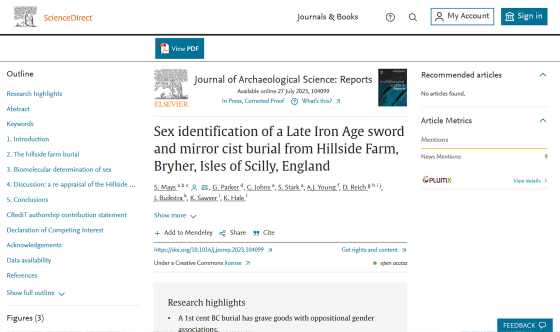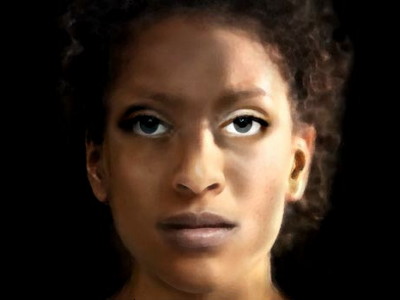It turns out that the corpse of about 2000 years ago, whose gender was unknown, was actually a female warrior from the enamel of the teeth

The remains of a 1st-century BC warrior discovered in 1999 in
Sex identification of a Late Iron Age sword and mirror cist burial from Hillside Farm, Bryher, Isles of Scilly, England - ScienceDirect
https://doi.org/10.1016/j.jasrep.2023.104099

New Scientific Study Solves Mystery of 2000-year-old Grave | Historic England
https://historicengland.org.uk/whats-new/news/new-scientific-study-solves-mystery-2000-year-old-grave/
Iron Age warrior woman was buried with a sword and a mirror | Live Science
https://www.livescience.com/archaeology/iron-age-warrior-woman-was-buried-with-a-sword-and-a-mirror
In 1999, a tomb dating from 100 to 50 BC was discovered on Brihaa , the smallest inhabited island in the Isles of Scilly. In addition to metal brooches and shields, among the burial goods of the corpses were the 'sword' that was generally buried with male warriors in the same period and region, and the 'hand mirror' that was buried with women. ” was included.
The pictures below show the iron sword and hand mirror that were actually buried with the corpse. The research team points out that this corpse is very unusual because grave goods associated with different genders were found at the same time.

The body was so badly damaged that only about 150g of bones and teeth were left. Based on the wear of the teeth, the age at death was estimated to be around 20 to 25 years old, but the bones were severely eroded due to aging, and researchers were unable to identify the sex by analyzing the DNA. He said he didn't.
Therefore, research teams such as
As a result of the analysis, the amelogenin contained in the teeth of the cadaver was identified as originating from the X chromosome, and none was found originating from the Y chromosome. In general, males have a pair of sex chromosomes 'X / Y' and females have a combination of 'X / X', so the research team concludes that the sex of the corpse is female with a probability of 96%. attached.

Approximately 2000 years ago, warfare in the Iron Age was dominated by surprise attacks, and it is believed that mirrors had practical utility such as communicating between allies and adjusting attack timing. Also, as a tool to communicate with the supernatural world, it seems that the mirror also had a symbolic meaning, such as praying for a successful raid or a safe return.
Dr Sarah Stark of Historic England said, 'The combination of sword and mirror suggests that this woman held a high position within her community, took command in local wars, and may have organized or led raids on rival groups. It suggests that there is,' he said, pointing out that women may have played a leading role in warfare in the Iron Age Isles of Scilly. 'This may suggest that women's involvement in assaults and other acts of violence in Iron Age societies was more common than previously thought.' I commented.

Related Posts:
in Science, Posted by log1h_ik







